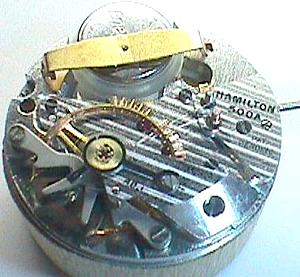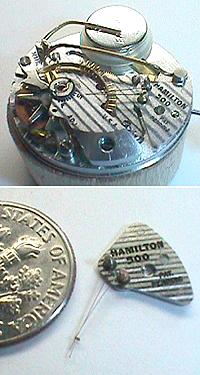René
Rondeau
P.O.
Box 391
Corte Madera, CA
94976
Email:
René
Rondeau
Questions or
Comments
about this site?
Webmaster
|
|
HOME | |
| INVENTORY | ||
| REPAIR | ||
| MOVEMENTS | ||
| HISTORY | ||
| CARE | ||
| BOOK | ||
| INTERVIEW | ||
| CUSTOMER COMMENTS |
Email:
René Rondeau

Member of American Watchmakers-Clockmakers Institute and the National Association of Watch & Clock Collectors since 1986.
Hamilton Electric
watches combine battery-power with a traditional mechanical watch
balance wheel and gear train. Though state-of-the-art in 1957,
this revolutionary technology quickly became obsolete and very
few watchmakers ever mastered the art of repairing these totally
unique and amazingly complex movements. The heart of these watches is
in their electrical contact systems. Unlike modern quartz watches
with transistor circuitry, the Hamilton Electric has microscopic
contact points physically making and breaking the electric circuit
five times each second --18,000 times every hour. Inevitably this
leads to wear on the tiny surfaces. This was not considered a
drawback in 1957, inasmuch as people were used to having their
mechanical watches serviced every 2-3 years anyway. During normal
maintenance of Hamilton Electric watches, contacts and balance
wheels were routinely renewed. (Even now all fine watches, whether
mechanical or electric, need periodic servicing to stay in good
running order. In today's throwaway society many people have lost
sight of this very important fact!)
-Since
1986-
Hamilton Electric Watch Movements
The first Hamilton Electric was the Model 500
| Released January 3, 1957 and produced into 1959. The critical contact wire/trip spring assembly consists of two very fine wires mounted to posts on the patent plate, which extend to the balance wheel as seen in the picture on the upper right. The picture on the lower right shows this assembly removed from the watch, with an ordinary dime as a scale reference. These wires are incredibly delicate, and they must be adjusted absolutely precisely. There is no margin for error in tension, height, length, angle, or position. Contact adjustment in the Model 500 is a time consuming, painstaking process which |
|
| requires a great deal of skill and experience, as even the slightest irregularity in their adjustment will prevent the watch from functioning properly. Once properly adjusted, however, the watch can run quite reliably for many years. (Extreme care must be taken when replacing the battery as the clamp is perilously close to the exposed wires.) | |
|
The Model 500A |
|
 |
Introduced in 1959, this was a modest improvement over the original Model 500. The wire battery clip was replaced with a simpler clamp, and the shockproof jewels were modified. Otherwise it is virtually identical |
| to the Model 500, with the same critical contact wires. | |
The Model 505
| This significantly improved movement was released in 1961. The delicate contact wire and trip spring were eliminated, replaced by a non-adjustable contact on the balance assembly. It is thus a simpler and more reliable watch, however there was one downside to this improvement. The contact pressure is much stronger than in the Model 500 and | |
| as a result the contacts wear more quickly. (In my restorations I routinely replace the contacts in Model 505 movements with new-old-stock original Hamilton factory parts, making them equivalent to factory-new.) |
|
| In all Hamilton Electrics this contact wear can be minimized by shutting off the watch whenever it is not being worn, by simply pulling out the stem. | |
Top


